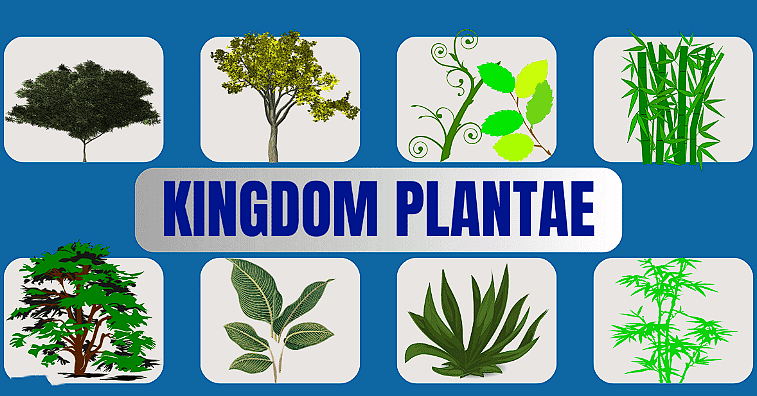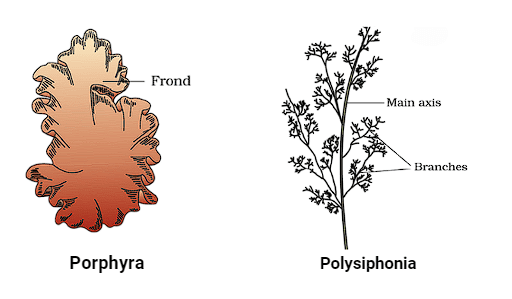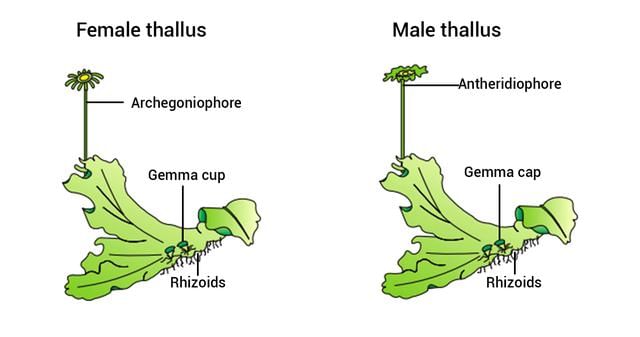Important Diagrams: Plant Kingdom | Biology Class 11 - NEET PDF Download
| Table of contents |

|
| 1. Algae |

|
| (a) Chlorophyceae (Green Algae) |

|
| (b) Phaeophyceae (Brown algae) |

|
| (c) Rhodophyceae (Red algae) |

|
| 2. Bryophytes |

|
| (a) Liverwort (Marchantia) |

|
| (b) Mosses |

|
The Plant Kingdom, or Plantae, includes all the different types of plants on Earth. These plants are made up of many cells and have a tough outer layer called a cell wall. They also have a green pigment called chlorophyll that helps them make their food through photosynthesis.

The Plant Kingdom has many different types of plants, ranging from tiny algae to giant trees like the Sequoia. Some plants have beautiful flowers, while others don't have any. Some plants have well-defined roots, stems, and leaves, while simpler plants have a more basic structure. Biologist Whittaker classified all living organisms into five groups, including Plantae, to help us understand them better. Learning about the different types of plants and how they are classified can help us understand more about each plant in detail.
1. Algae
(a) Chlorophyceae (Green Algae)
- Chlorophyceae: Class of green algae.
- Color and Chloroplasts: Green due to chlorophyll an and chlorophyll b pigments. Chloroplasts vary in shape (discoid, plate-like, etc.) and often contain pyrenoids for protein storage.
- Habitat: Mostly aquatic, some also found on land and in brackish or saline water.
- Flagella: Usually one, inserted apically or subapically, with a 9+2 arrangement under electron microscopy.
- Cellular Organization: Eukaryotic cells, with most having one nucleus, though some species may have many nuclei (coenocytic).
- Cell Wall Composition: Mainly cellulose, with variations in composition and sometimes containing calcium and magnesium carbonate.
- Protoplast and Cell Membrane: Protoplast is surrounded by a semi-permeable membrane within the cell wall. The cytoplasm contains numerous small vacuoles.

(b) Phaeophyceae (Brown algae)
- Phaeophyceae: Class of algae, known as brown algae.
- Color: Ranges from dark/light brown to olive green.
- Habitat: Primarily marine, found in chilly coastal seas, either free-floating or adhering to substrates.
- Size and Shape: Varied, from a few centimeters to 100 meters; diverse shapes including filamentous to giant kelps.
- Structure: Multicellular, with branches and filaments forming a thallus.
- Anchorage: Held by holdfasts, no true roots; stipe provides support.
- Leaf-like Structures: Laminae or blades; may contain gas-filled bladders (pneumatocysts) for buoyancy.
- Cell Wall: Cellulose inner layer, outer layer of sticky algin.
- Pigments: Chlorophylls a and c, fucoxanthin; autotrophic.
- Food Storage: Complex carbohydrates like laminarin (glucose polysaccharide) and mannitol (sugar alcohol).
- Functions of Mannitol: Acts as an osmoprotectant and antioxidant, storing carbon.
- Pyrenoids: Not typical, but present in some species.

(c) Rhodophyceae (Red algae)
- Habitat and Diversity: Where they live and their variety in marine and freshwater environments.
- Morphological Variability: Different physical forms they take, such as feathery or ribbon-like.
- Cell Wall Composition: The materials make up their cell walls, including agar-agar and cellulose.
- Cytoplasmic Connections: How multicellular species maintain connections through plasmodesmata.
- Nuclei and Chromatophores: Variation in nuclei count and presence of chromatophores.
- Pigments and Coloration: Pigments responsible for their red color, like xanthophylls and biliproteins.
- Reserve Foods: Stored nutrients like mannoglycerate and floridean starch.
- Reproductive Modes: Different methods of reproduction, including sexual and asexual.
- Economic Importance: Their ecological and commercial significance, such as agar production.
- Examples: Specific genera like Gracilaria, Gelidium, Porphyra, and Polysiphonia.

2. Bryophytes
Bryophytes, which include various types of mosses and liverworts, are commonly found in moist, shaded areas, especially in hilly regions. These plants are often referred to as the "amphibians of the plant kingdom" because, like amphibians, they can live on land (soil) but rely on water for their reproductive processes. Bryophytes typically thrive in damp, humid, and shaded environments.
(a) Liverwort (Marchantia)
Liverworts are small herbaceous plants with around 9000 species worldwide, often found in diverse environments like rocks, trees, and soil near rivers.

Characteristics:
- Their plant body is flat and thalloid, with leaves arranged in rows.
- They often form symbiotic relationships with fungi.
- Leaves are typically lobed or split, sometimes with serrated edges.
- Rhizoids are unicellular and hyaline.
- They contain oil bodies, a unique organelle.
- Sporophyte setae are made of enlarging parenchymatous cells.
- Capsules lack cuticles, columella, and stomata found in mosses and hornworts.
(b) Mosses
- The dominant stage in the life cycle of a moss is the gametophyte, which has two phases:
- Protonema stage: This stage develops directly from a spore. It is a creeping, green, branched, and often filamentous.
- Leafy stage: This stage arises from the secondary protonema as a lateral bud. It consists of upright, slender axes with spirally arranged leaves. These are anchored to the soil by multicellular, branched rhizoids.
- The leafy stage also produces the reproductive organs.
- Mosses reproduce vegetatively through fragmentation and budding in the secondary protonema.
- In sexual reproduction, the male (antheridia) and female (archegonia) sex organs are formed at the tips of the leafy shoots.
- After fertilization, the zygote develops into a sporophyte, which includes a foot, seta, and capsule. The sporophyte in mosses is more complex than in liverworts.
- The capsule contains spores, which are produced after meiosis. Mosses have a sophisticated mechanism for dispersing these spores.
- Common examples of mosses include Funaria,Polytrichum, and Sphagnum

|
169 videos|531 docs|136 tests
|
FAQs on Important Diagrams: Plant Kingdom - Biology Class 11 - NEET
| 1. What are some examples of algae? |  |
| 2. What are the characteristics of brown algae? |  |
| 3. How do red algae differ from other types of algae? |  |
| 4. What is liverwort, and what are its features? |  |
| 5. What is the life cycle of angiosperms? |  |
















